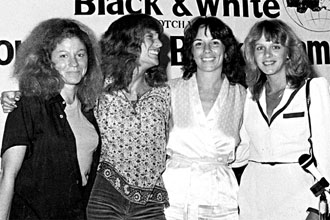|
| Magriel's NYT Columns |

Fran Goldfarb (left) with Leslie Stone,
Lee Genud, and Denise Hemingway Frances Goldfarb, one of the world’s top-ranked women players, took first place last weekend in a local tournament at the Barpoint House of Backgammon at 69 West 14th Street. Every Saturday night the Barpoint holds a knockout elimination tournament, which is open to nonmembers.
The diagrammed position occurred in the last game of the finals match between Miss Goldfarb (Black) and Richard Kuhn (White). Black has already doubled and now has the advantage.
White has been hit and still has a man on the bar waiting to reenter. In addition, White has three men in Black’s home board, whereas Black has only two men in White’s home board. More important, White’s men are trapped behind Black’s five-long prime (from the 4-point to the 8-point), while White’s prime (from the 20-point to the 17-point) is only four-long.
|
| Black to play 1-1. |
Miss Goldfarb, however, recognized that despite the apparent strength of this play (6/3*/2), it would be a serious error. Black’s primary concern is neither to attack White nor to defend the blot on the 2-point. As is often the case in such “prime versus prime” positions, the overriding consideration must be to avoid getting stuck behind the opponent’s prime. As long as Black maintains a five-long prime, White’s chances will be minimal.
The correct play is 23/21(2), simply moving both of Black’s back men up to the edge of White’s prime.
This play allows Black to move out from behind White’s prime with 5’s and 6’s. Thus, Black’s chances of getting trapped behind White’s prime, and consequently being forced to break up his own prime, are greatly reduced.
Furthermore, Black actually stands to gain by not hitting or making the 2-point. By allowing White to reenter immediately, Black gives White enough rope to hang himself. After White reenters, he may not be able to escape Black’s prime. Thus, it is quite likely that White will be forced to continue moving and his home-board position will completely disintegrate as he piles men on the 23- and 24-points.
Indeed, this was White’s fate in the actual game — Black won a gammon and the match.
Rollout
 Tom Keith 2013 |
|
Money play White owns 2-cube Black rolls 1-1 1296 games with VR Checker play: 2-ply Cube play: 3-ply Red |
| 1-1: | Game | G | BG | Equity | ||||
| 1 | 23/21(2) |
W L |
.8142 .1858 |
.3776 .0329 |
.0408 .0009 | +0.9401 |

| (b) |
| 2 | 23/22, 6/3* |
W L |
.7973 .2027 |
.4047 .0506 |
.0463 .0020 | +0.9145 | (0.0256) | |
| 10 | 6/3*/2 |
W L |
.7213 .2787 |
.3915 .0550 |
.0567 .0021 | +0.7139 | (0.2262) | (a) |

|
|

